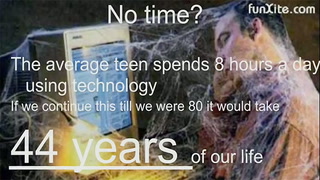TIMECODE COMMENT NOTES / TEXT ON SCREEN
TEXT:
Common Core: ELA
Delivering and Evaluating a Persuasive Speech
00:00:05 JULIE MANLEY: Today, I'm teaching a class where I'm asking my students to deliver their persuasive speeches. They've actually been preparing for these speeches for over three and a half weeks. TEXT:
Julie Manley
8th Grade ELA Teacher
Chinook Middle School, Bellevue, WA
00:00:12 JULIE MANLEY: In the last class, they analyzed a model speech for its effectiveness and their assignment was to apply what they learned to the writing of their own speech.
00:00:21 JULIE MANLEY: So, welcome to class. You guys, I want you to do a couple of things before we get going with our persuasive speeches today.
00:00:29 JULIE MANLEY: I start the class by reviewing the goal or the purpose of the day's learning, and then also by reviewing and discussing with students the expectations I have of them. TEXT:
Start class with review of goals
00:00:37 JULIE MANLEY: So, what I'd like for you to do is take a look at the speech number one. This is your viewing guide. This keeps you accountable, as a listener, also allows you to take some notes and shows me that you are actively participating.
00:00:51 JULIE MANLEY: In today's class, students did one of two roles. Either they were the speaker or they were the listener in the audience. I had the audience participants look at a viewing guide to record each speaker's claim and then evaluate the speech.
00:01:07 JULIE MANLEY: So, notice that there are three things I want you to do. Notice that we have a place for you to write the speaker's claim. What do you think I'm expecting of you with the explanation part? TEXT:
Speaker’s claim
00:01:19 JULIE MANLEY: I'm having you circle that student's strongest area, whether it be ideas, organization, use of language, or presentation, but what am I expecting you to explain? TEXT:
IDEAS
ORGANIZATION
LANGUAGE
PRESENTATION
00:01:30 BOY: You explain which one you think is the strongest.
00:01:33 JULIE MANLEY: The first step is for students to deliver their persuasive speech. So, one at a time, students would stand up and deliver what they have prepared for four minutes.
00:01:42 JULIE MANLEY: Brett, you are up.
00:01:47 BRETT: My topic is obsessive gaming. Studies shown by Elizabeth Hartney, a specialist and consultant with gaming addictions, found 10 to 15% of video game players meet the criteria for addiction. TEXT:
Common Core:
Present claims and findings in a coherent manner
00:01:59 BRETT: Addictions are mainly affecting young men and boys and more consultants] like Elizabeth Hartney looking to gaming addictions, the more they saw gaming was taking over the lives of kids.
00:02:10 BRETT: A video game itself does not make someone dumb. It is the distraction that causes it. TEXT:
Actual speech: 4 minutes
00:02:14 JULIE MANLEY: What I'd like to see my students be able to do are in two parts. As a speaker, I want my students to come to the class prepared, to have rehearsed their speech and to be able to deliver it in a way that is convincing using sound reasoning and accurate evidence.
00:02:30 JULIE MANLEY: As a listener, the second part, students in the audience, I expect them to really be thinking about what the speaker is saying, using the note taking guide to record the speaker's claim, and evaluate if that claim is a sound one and how it is supported.
00:02:47 JULIE MANLEY: What did you observe that Brett did well?
00:02:50 BOY: I thought he used really good logos and had a lot of, like, different facts which was really good. TEXT:
Effective use of logos
00:02:56 JULIE MANLEY: Every time you are evaluating a peer up here, you can be thinking about how that's going to inform your revision and your rehearsal. So, I would agree. His facts and figures were very strong.
00:03:06 JULIE MANLEY: Can you tell us more about his presentation? And you can look at the scoring guide.
00:03:11 BOY: He had a loud voice and he didn't, like, stare his paper, like, constantly.
00:03:17 GIRL: So, my topic is downloading music. I'm on the computer searching for this new song I've been dying to get. I get to the music store and look up the song. I realize it's $1.29 for the one song. I give up and just go back to downloading it off some website. This is outrageous. TEXT:
Common Core:
Present well-chosen details
00:03:35 JULIE MANLEY: Music should be free in the first place. I mean buying it is way too expensive. It takes more time to buy it. It prevents popularity to not well known or new artists. And it decreases the percentage of people that can afford it. TEXT:
Actual speech: 4 minutes
00:03:50 JULIE MANLEY: What did you notice that was strong? TEXT:
Know your audience
00:03:52 BOY: She used, like, a lot of voice behind her, it’s like, what she said. And, then, she could relate to the topic really well. And, so, she knew what the people who, went through, buying musics, [sic] buying music went through kind of. TEXT:
Effective use of imagery
00:04:06 JULIE MANLEY: She definitely knew her audience, but do you want to add onto that?
00:04:09 BOY: In her beginning, she used really good imagery of, like, what she, her own experience.
00:04:15 JULIE MANLEY: Audience, you've been fantastic so far. Thank you for giving your positive attention.
00:04:19 GIRL: My topic is that we need to disconnect the plug in order to help our relationships in modern days. In recent studies conducted by the Harris Interactive Team Research Society, teenagers are spending close to eight hours a day using technology. TEXT:
Common Core:
Emphasize salient points in a focused manner
00:04:35 GIRL: If we continue this pattern throughout the course of our lives, we will have spent forty-four years straight of waking hours just sitting behind a screen.
00:04:43 GIRL: How are we supposed to cultivate and develop these close and long withstanding relationships if we're behind these, constantly chained to our addictive gadgets? TEXT:
Actual speech: 4 minutes
00:04:53 GIRL: We spend so much time and energy expending on building empire [sounds like] friends virtually, but we fail to focus our time and energy growing our genuine friendships that will prevail in reality. TEXT:
Common Core:
Use multimedia
00:05:06 JULIE MANLEY: So, to focus the type of feedback that I was hoping students would give their peer who just spoke, I assigned a particular component of the rubric.
00:05:17 JULIE MANLEY: So, you two, these two tables, think about her ideas. So, look at the rubric and craft a statement of what you noticed that she did well having to do with ideas.
00:05:27 BOY: I think she made her ideas clear and we knew what the claim was. TEXT:
Clear presentation of ideas and claim
00:05:33 BOY: Yes, the claim was important to know because, when you know the claim, then you can know the entire speech, what it's about.
00:05:40 JULIE MANLEY: What did you observe by way of Lynea's presentation that you thought was successful, and you can raise your hand. Connor?
00:05:48 CONNOR: When she was talking, she was, like, really confident in what she was saying. Like, she really believed it. I mean she brought that out by, like, using a lot of really good word choice. TEXT:
Common Core:
Delineate a speaker’s argument and specific claims
00:05:57 JULIE MANLEY: One of the last steps I always like to ask students to perform is some sort of reflection. And, so, in today's class, I had them perform a reflective quick write asking them to think about the speeches that they observed today and craft a be sure to statement.
00:06:15 JULIE MANLEY: If you did not go today, I want you to write yourself one be sure to statement. We use that a lot. What are you going to now be sure to do during your speech based on what you saw?
00:06:25 BOY: I said loud voices and not shake when you're presenting.
00:06:32 JULIE MANLEY: And it's hard, so just take a deep breath, a deep breath. Hold onto your viewing guide. I'm really excited for tomorrow's speeches. If you didn't go today, you're going to go tomorrow.
00:06:40 JULIE MANLEY: What surprised and delighted me at the end of this unit was students' ability to become very passionate about their topic.
00:06:49 JULIE MANLEY: And because they cared so deeply about the topic, they were able to really master the skills of creating a clear position through their claim and finding the most sound reasoning and the best evidence to support that claim.
00:07:05 JULIE MANLEY: The standards addressed in this class revolve around many of the speaking and listening standards and, specifically, coming to a class prepared to deliver the speech, also to be able to deliver a oral presentation that can base a claim that is backed up with reasoning and evidence. TEXT:
Tch Classroom Takeaways:
Common Core
Speaking and Listening:
1. Come prepared to deliver speech
2. Present claims backed with sound evidence
3. Use multimedia to enhance ideas
4. Evaluate claims
00:07:25 JULIE MANLEY: Another important standard that students addressed today was their ability to use multimedia or a visual display to enhance their ideas. And then last, as a listener, being able to evaluate one's claim and think about if one's own perspective is changed.
LOGO:
Tch TeachingChannel













7 Comments
David Jones Feb 11, 2016 4:40pm
Peggy Gates Jul 22, 2015 11:23am
Janie Samreth Oct 28, 2014 7:32pm
Kay Rutherford Aug 5, 2014 2:10am
Michelle Jennings Aug 9, 2013 5:44pm